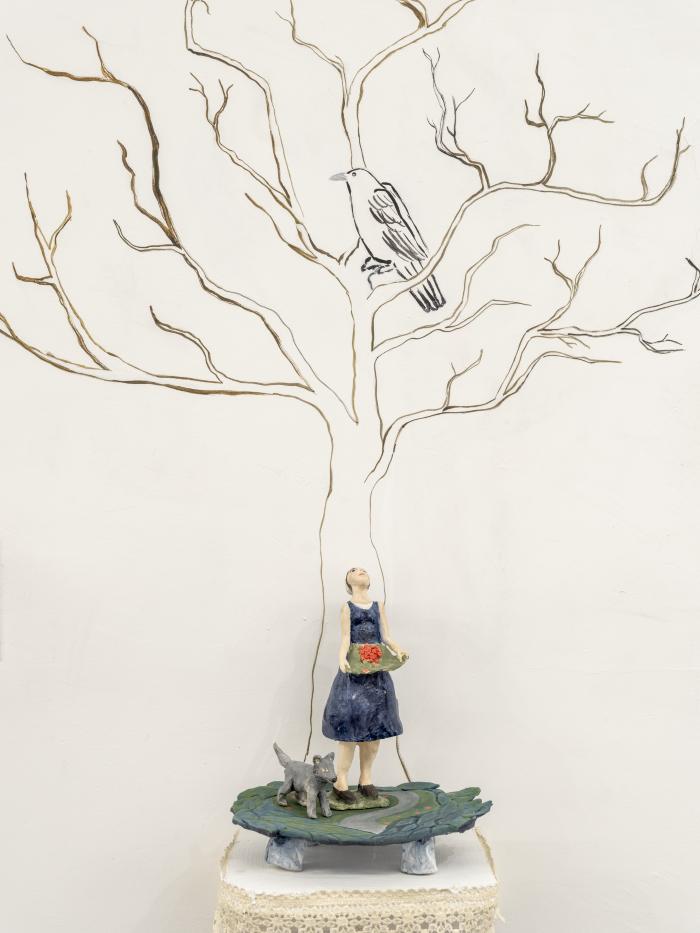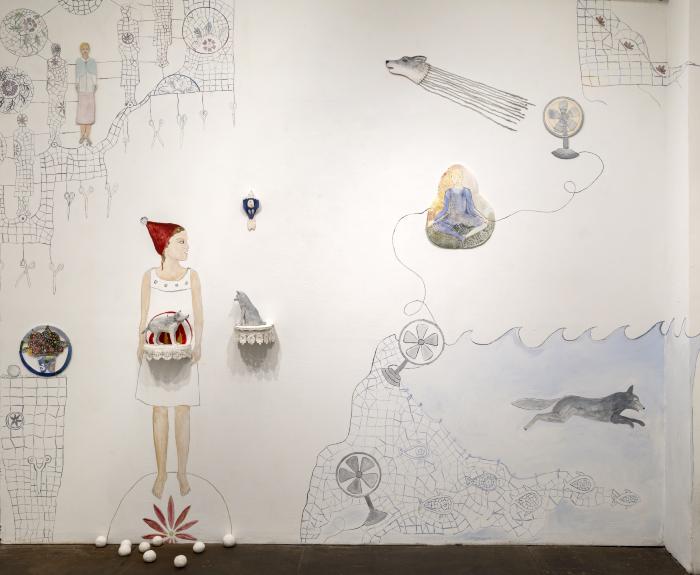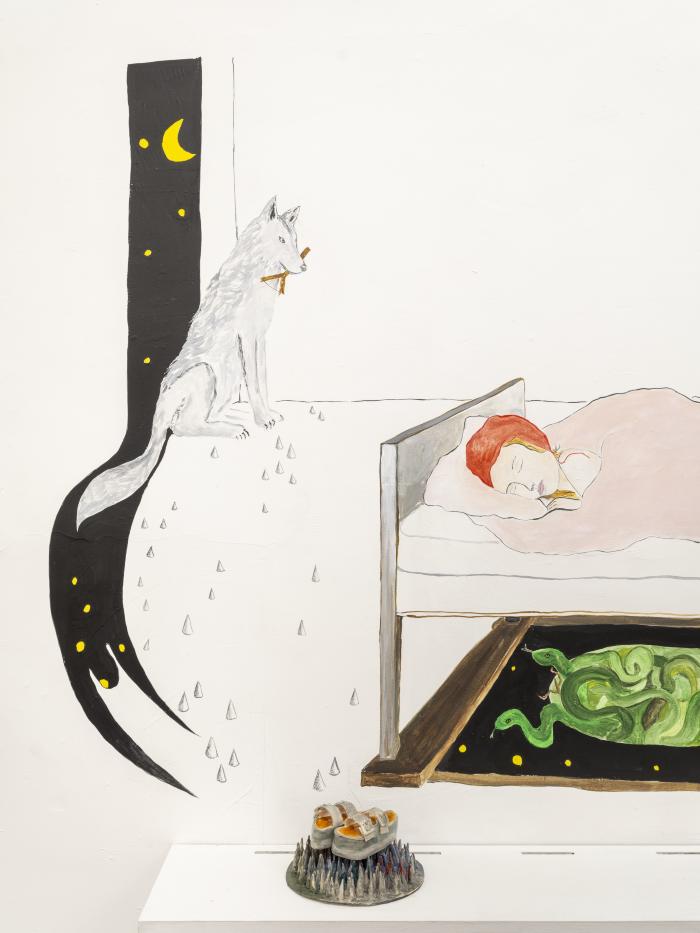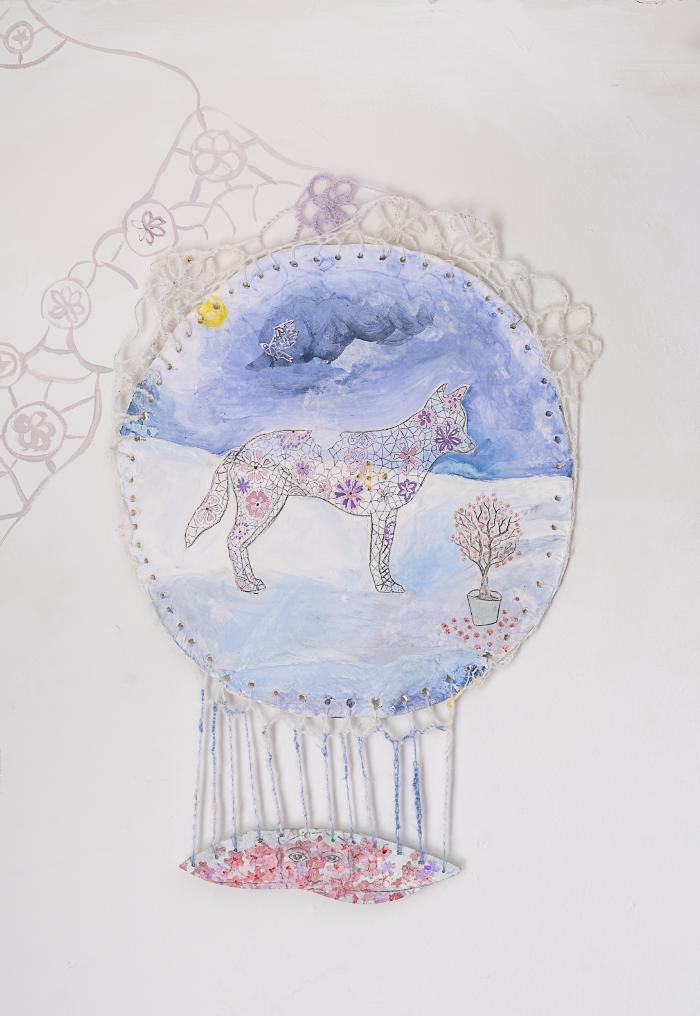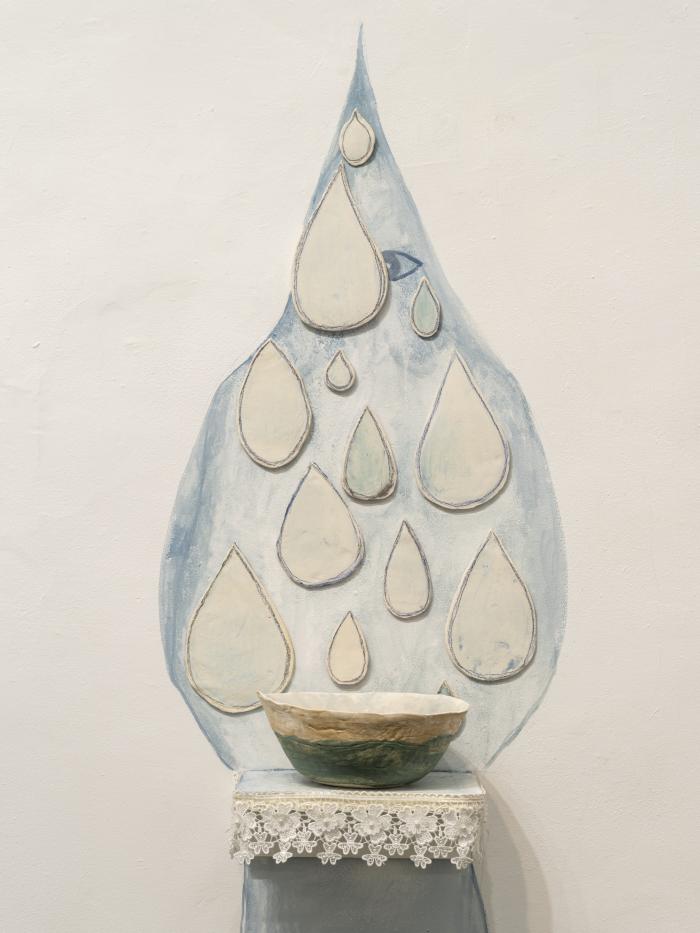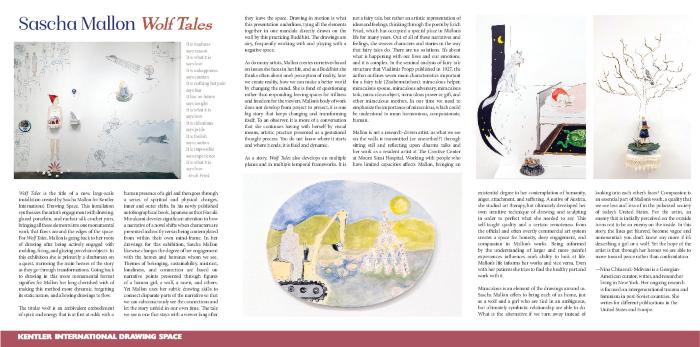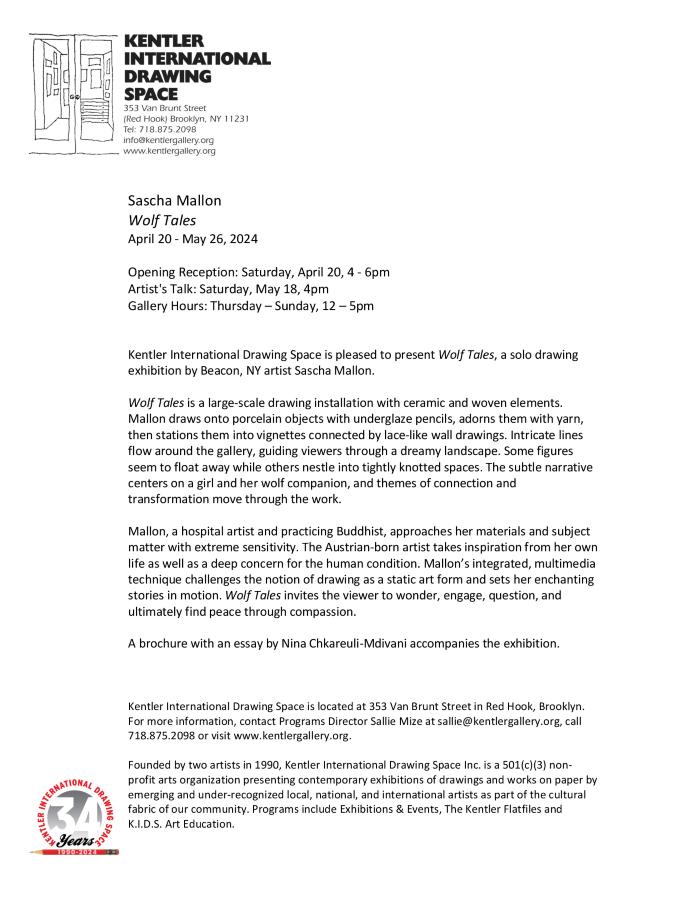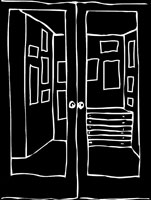exhibition
Sascha Mallon, Wolf Tales
Solo Exhibition
Date
April 20 – May 26, 2024Opening Reception
April 20, 2024exhibition Images
Click to Enlarge.
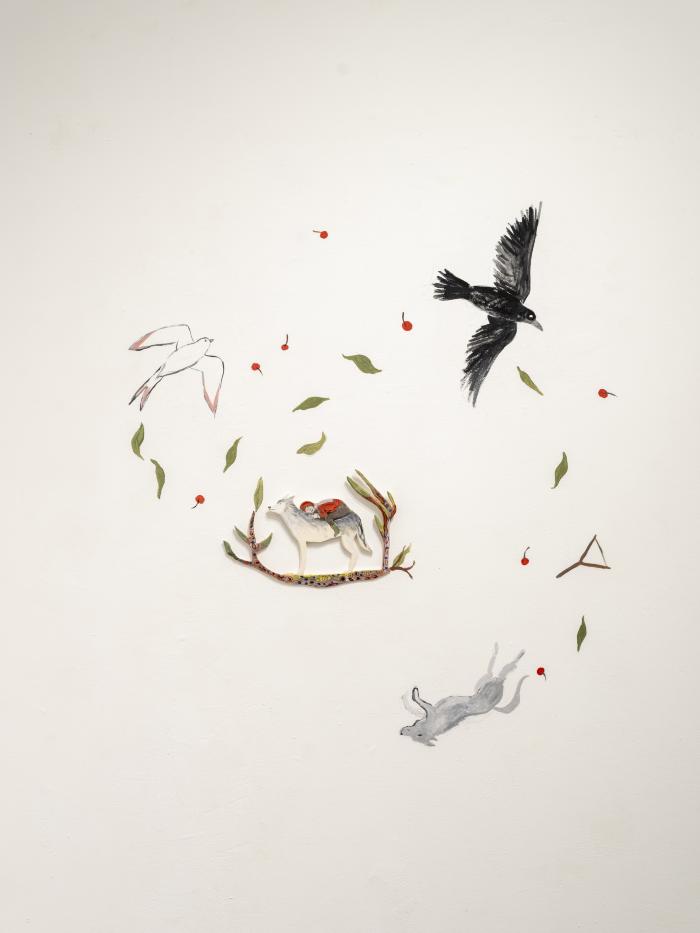
Sascha Mallon, How Can We Bring Each Other Home?, 2024, wall drawing and ceramic (photo credit: Stephen Mallon)
Press and Promotion
About the exhibition
Sascha Mallon
Wolf Tales
April 20 - May 26, 2024
Opening Reception: Saturday, April 20, 4 - 6pm
Artist’s Talk: Saturday, May 18, 4pm
Gallery hours: Thursday - Sunday, 12 - 5pm
WOLF TALES
“It is madness
says reason
It is what it is
says love
It is unhappiness
says caution
It is nothing but pain
says fear
It has no future
says insight
It is what it is
says love
It is ridiculous
says pride
It is foolish
says caution
It is impossible
says experience
It is what it is
says love.”
- Erich Fried
Wolf Tales is the title of a new, large-scale installation created by Sascha Mallon for Kentler International Drawing Space. This installation synthesizes the artist’s engagement with drawing, glazed porcelain, and mohair silk crochet yarn, bringing all these elements into one monumental work that flows around the edges of the space. For Wolf Tales, Mallon is going back to her roots of drawing after being actively engaged with molding, firing, and glazing porcelain objects. In this exhibition she is primarily a draftsman on a quest, mirroring the main heroes of the story as they go through transformations. Going back to drawing in this more monumental format signifies for Mallon her long-cherished wish of making this method more dynamic, forgetting its static nature, and allowing drawings to flow.
The titular wolf is an ambivalent embodiment of spirit and energy that is at first at odds with a human presence of a girl and then goes through a series of spiritual and physical changes, inner and outer shifts. In his newly published autobiographical book, Japanese author Haruki Murakami devotes significant attention to how a narrative of a novel shifts when characters are presented indirectly versus being contemplated from within their own mind-frame. In her drawings for this exhibition, Sascha Mallon likewise changes the degree of her engagement with the heroes and heroines whom we see. Themes of belonging, sustainability, mistrust, loneliness, and connection are based on narrative points presented through figures of a human girl, a wolf, a raven, and others. Yet Mallon uses her subtle drawing skills to connect disparate parts of the narrative so that we can subconsciously see the connections and let the story unfold in our own time. The tale we see is one that stays with a viewer long after they leave the space. Drawing in motion is what this presentation underlines, tying all the elements together in one mandala directly drawn on the wall by this practicing Buddhist. The drawings are airy, frequently working with and playing with a negative space.
As do many artists, Mallon creates narratives based on issues she faces in her life, and as a Buddhist she thinks often about one’s perception of reality, how we create reality, how we can make a better world by changing the mind. She is fond of questioning rather than responding, leaving spaces for stillness and freedom for the viewers. Mallon’s body of work does not develop from project to project, it is one big story that keeps changing and transforming itself. To an observer, it is more of a conversation that she continues having with herself by visual means, artistic practice presented as a gestational thought process. You do not know where it starts and where it ends; it is fluid and dynamic.
As a story, Wolf Tales also develops on multiple planes and in multiple temporal frameworks. It is not a fairy tale, but rather an artistic representation of ideas and feelings, thinking through the poem by Erich Fried, which has occupied a special place in Mallon’s life for many years. Out of all of these narratives and feelings, she weaves characters and stories in the way that fairy tales do. There are no solutions. It’s about what is happening with our lives and our emotions, and it is complex. In the seminal analysis of fairy tale structure that Vladimir Propp published in 1927, the author outlines seven main characteristics important for a fairy tale (Zaubermärchen ): miraculous helper, miraculous spouse, miraculous adversary, miraculous task, miraculous object, miraculous power or gift, and other miraculous motives. In our time we need to emphasize the importance of miraculous, which could be understood to mean harmonious, compassionate, human.
Mallon is not a research-driven artist, as what we see on the walls is transmitted (or unearthed?) through sitting still and reflecting upon dharma talks and her work as a resident artist at The Creative Center at Mount Sinai Hospital. Working with people who have limited capacities affects Mallon, bringing an existential degree to her contemplation of humanity, anger, attachment, and suffering. A native of Austria, she studied art therapy, but ultimately developed her own intuitive technique of drawing and sculpting in order to perfect what she needed to say. This self-taught quality and a certain remoteness from the official and often overtly commercial art system creates a space for honesty, deep engagement, and compassion in Mallon’s works. Being informed by the understanding of larger and more painful experiences influences one’s ability to look at life. Mallon’s life informs her works and vice versa. Even with her patients she tries to find the healthy part and work with it.
Miraculous is an element of the drawings around us. Sascha Mallon offers to bring each of us home, just as a wolf and a girl who are tied in an ambiguous, but ultimately symbiotic relationship are able to do. What is the alternative if we turn away instead of looking into each other’s faces? Compassion is an essential part of Mallon’s work, a quality that we see less and less of in the polarized society of today’s United States. For the artist, an enemy that is initially perceived on the outside turns out to be an enemy on the inside. In this story, the lines get blurred, become vague and nonessential: you don’t know any more if it’s describing a girl or a wolf. Yet the hope of the artist is that through her heroes we are able to move toward peace rather than confrontation.
—Nina Chkareuli-Mdivani is a Georgian-American curator, writer, and researcher living in New York. Her ongoing research is focused on intergenerational trauma and feminism in post-Soviet countries. She writes for different publications in the United States and Europe.
WOLF TALES video by Stephen Mallon:
